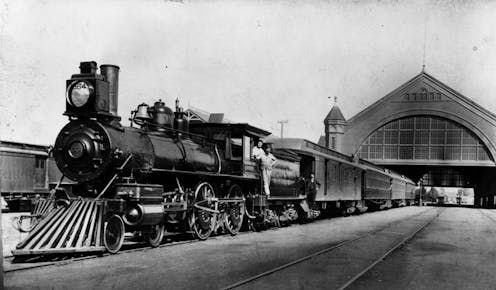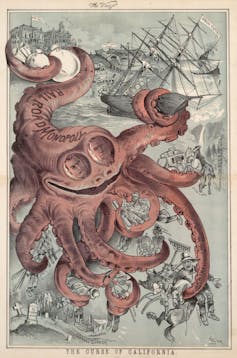For tech giants, a cautionary tale from 19th century railroads on the limits of competition
Efforts to curb railroads' monopoly power in the 19th century hold lessons for 21st-century policymakers and internet giants alike.

Late 19th-century Americans loved railroads, which seemed to eradicate time and space, moving goods and people more cheaply and more conveniently than ever before. And they feared railroads because in most of the country it was impossible to do business without them.
Businesses, and the republic itself, seemed to be at the mercy of the monopoly power of railroad corporations. American farmers, businessmen and consumers thought of competition as a way to ensure fairness in the marketplace. But with no real competitors over many routes, railroads could charge different rates to different customers. This power to decide economic winners and losers threatened not only individual businesses but also the conditions that sustained the republic.

That may sound familiar. As a historian of that first Gilded Age, I see parallels between the power of the railroads and today’s internet giants like Verizon and Comcast. The current regulators – the Federal Communications Commission’s Republican majority – and many of its critics both embrace a solution that 19th-century Americans tried and dismissed: market competition.
Monopolies as natural and efficient
In the 1880s, the most sophisticated railroad managers and some economists argued that railroads were “natural monopolies,” the inevitable consequence of an industry that required huge investments in rights of way over land, constructing railways, and building train engines and rail cars.
Competition was expensive and wasteful. In 1886 the Atchison, Topeka and Santa Fe Railway and the Missouri Pacific Railroad both built railroad tracks heading west from the Great Bend of the Arkansas River in Kansas to Greeley County on the western border, roughly 200 miles away. The tracks ran parallel to each other, about two miles apart. Charles Francis Adams, president of the Union Pacific Railroad, called this redundancy the “maddest specimen of railroad construction of which” he had ever heard. And then his own railroad built new tracks into western Kansas, too.
After ruinous bouts of competition like this, rival railroad companies would agree to cooperate, pooling the business in certain areas and setting common rates. These agreements effectively established monopolies, even if more than one company was involved.
Monopolies as unfairly subsidized
Anti-monopolists who opposed the railroads’ power argued that monopolies originated not as a result of efficient investment strategies, but rather from special privileges afforded by the government. Railroads had the ability to condemn land to build their routes. They got subsidies of land, loans, bonds and other financial aid from federal, state and local governments. Their political contributions and favors secured them supporters in legislatures, Congress and the courts.
As stronger railroads bought up weaker companies and divided up markets with the remaining competitors, the dangers of monopoly became more and more apparent. Railroad companies made decisions on innovation based on the effects on their bottom line, not societal values. For instance, the death toll was enormous: In 1893, 1,567 trainmen died and 18,877 were injured on the rails. Congress enacted the first national railroad safety legislation that year because the companies had insisted it was too expensive to put automatic braking systems and couplers on freight trains.
But a monopoly’s great economic and societal danger was its ability to decide who succeeded in business and who failed. For example, in 1883 the Northern Pacific Railway raised the rates it charged O.A. Dodge’s Idaho lumber company. The new rates left Dodge unable to compete with the rival Montana Improvement Company, reputedly owned by Northern Pacific executives and investors. Dodge knew the game was up. All he could do was ask if they wanted to buy his company.
For anti-monopolists, Dodge’s dilemma went to the heart of the issue. Monopolies were intrinsically wrong because they unfairly influenced businesses’ likelihood of success or failure. In an 1886 report on the railroad industry, the U.S. Senate Select Committee on Interstate Commerce agreed, stating clearly that the “great desideratum is to secure equality.”
Turning to regulators for help
To achieve equality, anti-monopolists wanted more government regulation and enforcement. By the late 1880s, some railroad executives were starting to agree. Their efforts at cooperation had failed because railroads treated each other no better than they did their customers. As Charles Francis Adams put it, his own industry’s “method of doing business is founded upon lying, cheating, and stealing: all bad things.”
The consensus was that the railroads needed the federal government to enforce the rules, bringing greater efficiency and ultimately lower rates. But Congress ran into a problem: If an even, competitive playing field depended on regulation, the marketplace wasn’t truly open or free.
The solution was no clearer then than it is now. The technologies of railroads inherently gave large operators advantages of efficiency and profitability. Large customers also got benefits: John D. Rockefeller of Standard Oil, for example, could guarantee large shipments and provide his own tank cars – so he got special rates and rebates. Newcomers and small enterprises were left out.
Some reformers suggested accepting monopolies, so long as their rates were carefully regulated. But the calculations were complex: Charges by the mile ignored the fact that most costs came not from transport but rather from loading, unloading and transferring freight. And even the best bookkeepers had a hard time unraveling railway accounts.
Managing power
The simplest solution, advanced by the Populist party and others, was the most difficult politically: nationalize the railroad routes. Turning them into a publicly owned network, like today’s interstate highway system, would give the government the responsibility to create clear, fair rules for private companies wishing to use them. But profitable railroads opposed it tooth and nail, and skeptical reformers did not want the government to buy derelict and unprofitable railroads.
The current controversy about the monopolistic power of internet service providers echoes those concerns from the first Gilded Age. As anti-monopolists did in the 19th century, advocates of an open internet argue that regulation will advance competition by creating a level playing field for all comers, big and small, resulting in more innovation and better products. (There was even a radical, if short-lived, proposal to nationalize high-speed wireless service.)
However, no proposed regulations for an open internet address the existing power of either the service providers or the “Big Five” internet giants: Apple, Amazon, Facebook, Google and Microsoft. Like Standard Oil, they have the power to wring enormous advantages from the internet service providers, to the detriment of smaller competitors.
The most important element of the debate – both then and now – is not the particular regulations that are or are not enacted. What’s crucial is the wider concerns about the effects on society. The Gilded Age’s anti-monopolists had political and moral concerns, not economic ones. They believed, as many in the U.S. still do, that a democracy’s economy should be judged not only – nor even primarily – by its financial output. Rather, success is how well it sustains the ideals, values and engaged citizenship on which free societies depend.
When monopoly threatens something as fundamental as the free circulation of information and the equal access of citizens to technologies central to their daily life, the issues are no longer economic.
Richard White receives funding from Stanford Humanities Center, Huntington Library. They gave me money but neither is connected to this subject.
Read These Next
West Coast levee failures show growing risks from America’s aging flood defenses
Levees protect more than 7 million buildings in the US today, yet they got a D-plus grade in 2025. A…
LA fires showed how much neighborliness matters for wildfire safety – schools can do much more to te
Managing fire risk is about more than regulations and rules. It’s also about caring for neighbors…
Has the Fed fixed the economy yet? And other burning economic questions for 2026
As 2026 begins, uncertainty is at the top of everyone’s mind.






